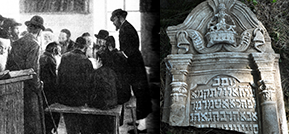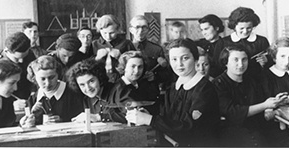During the past summer, we returned to Galicia, to the Tarnopol region. The eighth annual delegation of the Jewish Galicia and Bukovina Organization began the work of documenting the ancient Jewish cemetery in Buczacz, S.Y. Agnon’s home town. This cemetery holds a special place in those of Agnon’s works devoted to his home town. It symbolizes the continuity of generations in the city and is an important component in the special Jewish space in which the plots of his many stories take place.
The current state of the cemetery is pitiful. The hilltop on which the Jewish residents of Buczaz buried their dead for hundreds of years, which rises above the city of Buczaz, is entirely covered by plants, thorns and impenetrable thickets. The entire space of the cemetery is filthy and neglected, and it is difficult to access the graves.
In addition, the cemetery suffered extensive damage during the 20th century as a result of battles that took place in its vicinity during the First World War, and as a result of intentional desecration during the Holocaust. During the Soviet rule hundreds of headstones that had survived earlier destruction were taken from the cemetery and used as building materials. Despite all this, the Jewish cemetery of Buczaz is still one of the most important Jewish historical sites in Eastern Galicia.
In preparation for the arrival of the delegation extensive clearing and ground prep were undertaken. The group of 14 volunteers – students of the Herzog College and universities and graduates of hesder yeshivot – worked in Buczaz for two weeks, from July 30th through August 13th. Dr. Boris Khaimovich, an expert on Jewish art, and Dr. Ilia Luria, a scholar of Eastern Europe from the Hebrew University in Jerusalem, led the delegation. About 1,000 gravestones were discovered, cleaned, documented and photographs during the two weeks of work. At times, the gravestones needed to be turned over or dug under in order to reach the writing on them.
The delegation produced important findings: a few gravestones from the end of the 16th century and the first half of the 17th – i.e. the period before the 1648 Khmelnytsky massacre – were revealed. Such findings are quite rare in Eastern Europe and are a testimony to the longevity and strength of the Jewish community of Buczaz. Most of the gravestones documented were from the 18th and early 19th centuries.
The delegation managed to document about half of the graves from the Buczaz graveyard. In addition, a precise mapping out of all of the documented gravestones was made. We plan to return to Buczaz next year and complete the documentation work.
The complete findings of the delegation will be deciphered, processed and made available on the Jewish Galicia and Bukovina Association’s website in the near future.






